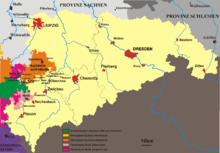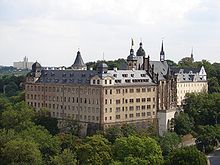- Saxe-Altenburg
-
Duchy of Saxe-Altenburg
Herzogtum Sachsen-AltenburgState of the Holy Roman Empire,
State of the German Confederation,
State of the North German Confederation,
State of the German Empire,
State of the Weimar Republic← 
1602–1672
1826–1918
1918–1920† →
→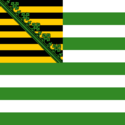

Flag Coat of arms Anthem
Heil unserm Herzog, heil
(Hail to our Duke, hail!)Saxe-Altenburg within the German Empire
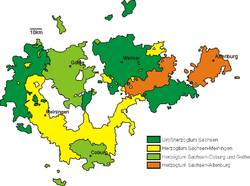
Ernestine duchies after 1825, showing Saxe-Altenburg in orangeCapital Altenburg Government Principality Duke - 1603–13 Christian II, Elector of Saxony (regent for John Philip) - 1669–72 John George II, Elector of Saxony (regent for Frederick William III) - 1826–34 Frederick - 1908–18 Ernst II History - Saxe-Weimar partitioned 7 July 1602 - Personal union with
Saxe-Gotha*
1672–1825- Ernestine duchies
rearranged, duchy
restored
12 November 1826- German Revolution November 1918 - Merger of Thuringia‡ 1920 Area - 1905 1,323 km2 (511 sq mi) Population - 1905 est. 207,000 Density 156.5 /km2 (405.2 /sq mi) * See Saxe-Gotha-Altenburg
† As Free State of Saxe-Altenburg
‡ In 1920, the ex-Imperial states of Saxe-Altenburg, Saxe-Meiningen, Saxe-Coburg-Gotha, Saxe-Weimar-Eisenach, Schwarzburg-Sondershausen, Schwarzburg-Rudolstadt and the two principalities of Reuß all merged to form the Free State of Thuringia.Saxe-Altenburg (German: Sachsen-Altenburg) was one of the Saxon duchies held by the Ernestine branch of the Wettin dynasty in present-day Thuringia.[1]
Contents
History
Castle of Altenburg
The duchy originated from the medieval Burgraviate of Altenburg in the Imperial Pleissnerland (Terra Plisensis), a possession of the Wettin Margraves of Meissen since 1243. Upon a partition treaty of 1485, Altenburg fell to Elector Ernest of Saxony, the progenitor of the Ernestine Wettins.[2] After the Division of Erfurt in 1572 among Duke John William of Saxony and his nephews, Altenburg fell to his Duchy of Saxe-Weimar.
When in 1602 John William's son and successor Frederick William I died, the Duchy of Saxe-Weimar passed to his younger brother John II, while in 1603 Frederick William's eldest son John Philip in compensation received the newly created Duchy of Saxe-Altenburg. It was an Imperial State in its own right, with a vote in the Reichstag, for much of the 17th century until the extinction of its ruling line in 1672, when it was inherited by Ernest I the Pious, the Duke of Saxe-Gotha, who had married the heiress.
Saxe-Altenburg thereafter remained part of Saxe-Gotha-Altenburg until the extinction of that house in 1825, when Gotha and Altenburg were split up, with Gotha going to the Duke of Saxe-Coburg-Saalfeld and Altenburg to the Duke of Saxe-Hildburghausen, who in exchange gave up Hildburghausen to the Duke of Saxe-Meiningen. This family ruled in the duchy until the end of the monarchies in the course of the German Revolution of 1918–1919. The succeeding Free State of Saxe-Altenburg was incorporated into the new state of Thuringia in 1920.
Saxe-Altenburg had an area of 1,323 km² and a population of 207,000 (1905). Its capital was Altenburg.
The Saxe-Altenburg line became extinct following the death of Prince George Moritz in 1991.
Dukes of Saxe-Altenburg
Elder line
- John Philip, Duke of Saxe-Altenburg (1603–1639)
- Frederick William II, Duke of Saxe-Altenburg (1639–1669)
- Frederick William III, Duke of Saxe-Altenburg (1669–1672)
Line extinct, inherited by Saxe-Gotha, thereupon Saxe-Gotha-Altenburg
Junior line
- Frederick, Duke of Saxe-Altenburg (1826–1834) (Previously Duke of Saxe-Hildburghausen)
- Joseph, Duke of Saxe-Altenburg (1834–1848)
- Georg, Duke of Saxe-Altenburg (1848–1853)
- Ernst I, Duke of Saxe-Altenburg (1853–1908)
- Ernst II, Duke of Saxe-Altenburg (1908–1918)
Heads of the Ducal House of Saxe-Altenburg, post monarchy
- Ernst II, Duke of Saxe-Altenburg (1918–1955)
- Georg Moritz, Hereditary Prince of Saxe-Altenburg (1955–1991)
In 1991 the Saxe-Altenburg line became extinct. Its representation was merged with the one of Saxe-Weimar-Eisenach.
Two branches descend from duke Ernest the Pious, the father of the progenitor of this Saxe-Altenburg branch: Saxe-Meiningen and Saxe-Coburg and Gotha; according to old Wettin family law, they would have divided the actual territories between them (as happened to Gotha and Altenburg in 1826).
See also
References
- ^ "The Ernestine Line's Saxon Duchies" (Web). Historical Atlas. Tacitus Historical Atlas. http://www.tacitus.nu/historical-atlas/regents/germany/saxony2.htm. Retrieved 2007-05-19.
- ^
 "Saxe-Altenburg". Catholic Encyclopedia. New York: Robert Appleton Company. 1913.
"Saxe-Altenburg". Catholic Encyclopedia. New York: Robert Appleton Company. 1913.
External links
- Saxe-Altenburg family genealogy
- Herzogtum Sachsen-Altenburg
 Chisholm, Hugh, ed (1911). "Saxe-Altenburg". Encyclopædia Britannica (11th ed.). Cambridge University Press.
Chisholm, Hugh, ed (1911). "Saxe-Altenburg". Encyclopædia Britannica (11th ed.). Cambridge University Press.
Saxe-Weimar (1572–1806) · Saxe-Coburg-Eisenach (1572–1596, 1633-1638) · Saxe-Coburg (1596–1633, 1681–1699) · Saxe-Eisenach (1596–1638, 1640–1644, 1672–1806) · Saxe-Altenburg (1603–1672, 1826–1918) · Saxe-Gotha (1640–1680) · Saxe-Gotha-Altenburg (1681–1826) · Saxe-Marksuhl (1662–1672) · Saxe-Jena (1672–1690) · Saxe-Eisenberg (1680–1707) · Saxe-Hildburghausen (1680–1826) · Saxe-Römhild (1680–1710) · Saxe-Saalfeld (1680–1735) · Saxe-Meiningen (1681–1918) · Saxe-Coburg-Saalfeld (1735–1826) · Saxe-Weimar-Eisenach (1806–1918) · Saxe-Coburg and Gotha (1826–1918)

 Upper Saxon Circle (1512–1806) of the Holy Roman Empire
Upper Saxon Circle (1512–1806) of the Holy Roman EmpireElectorates 
Ecclesiastical Secular Anhalt (Bernburg · Köthen · Zerbst) · Barby · Hatzfeld-Gleichen · Pomerania (Further · Hither) · Querfurt · Reuss (Elder · Junior) · Saxe-Altenburg · Saxe-Coburg · Saxe-Eisenach · Saxe-Gotha · Saxe-Weimar · Schwarzburg (Rudolstadt · Sondershausen)Prelates Counts / Lords Hohnstein · Lohra / Klettenberg · Mansfeld · Schönburg (Saale) · Stolberg (Stolberg · Wernigerode · Rossla) States of the German Confederation (1815–66)
States of the German Confederation (1815–66)Empires 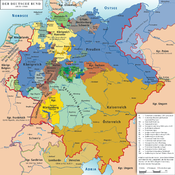
Kingdoms Electorates Grand Duchies Duchies Anhalt (Bernburg2 · Dessau2 · Köthen3) · Brunswick · Holstein · Limburg4 · Nassau · Saxe-Lauenburg · Saxony (Altenburg5 · Coburg-Saalfeld6 · Coburg-Gotha5 · Gotha-Altenburg6 · Hildburghausen6 · Meiningen)Principalities Hesse-Homburg · Hohenzollern (Hechingen7 · Sigmaringen7) · Liechtenstein · Lippe · Reuss (Elder · Junior) · Schaumburg-Lippe · Schwarzburg (Rudolstadt · Sondershausen) · Waldeck and PyrmontCity-states Other territories
outside of the
confederacyColonial possessions · Personal unions of Habsburg (Bukovina · Croatia · Galicia and Lodomeria · Hungary · Lombardy–Venetia · Serbian Voivodeship and Banat8 · Slavonia9 · Transylvania) · Personal union of Hanover (Great Britain and Ireland10) · Personal unions of Hohenzollern (East Prussia11 · Neuchâtel12 · Posen, Gr. Duchy13 · Posen, Prov.14 · Prussia, Prov.15 · West Prussia11) · Occupied: Schleswig161 w/o areas listed under other territories. 2 Merged with Anhalt from 1863. 3 until 1847. 4 from 1839. 5 from 1826. 6 until 1826. 7 until 1850. 8 1849–60. 9 as of 1849. 10 until 1837. 11 until 1829. 12 until 1848/57. 13 until 1848. 14 as of 1848. 15 as of 1829. 16 as of 1864. States of the North German Confederation (1866–71)
States of the North German Confederation (1866–71)Kingdoms 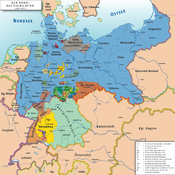
Grand Duchies Duchies Principalities Schaumburg-Lippe · Schwarzburg (Rudolstadt · Sondershausen) · Lippe · Reuss (Elder · Junior) · Waldeck-PyrmontCity-states  States of the German Empire (1871–1918)
States of the German Empire (1871–1918)Kingdoms 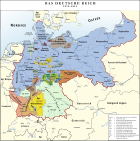
Grand Duchies Duchies Anhalt · Brunswick · Saxe-Altenburg · Saxe-Coburg and Gotha · Saxe-Lauenburg (until 1876) · Saxe-MeiningenPrincipalities Schaumburg-Lippe · Schwarzburg-Rudolstadt · Schwarzburg-Sondershausen · Lippe · Reuss Elder Line · Reuss Junior Line · Waldeck-PyrmontCity-states Other territories Elsaß-Lothringen · Colonial possessions States of Germany during the Weimar Republic (1919–33)
States of Germany during the Weimar Republic (1919–33)States Anhalt · Baden · Bavaria · Brunswick · Hesse · Lippe · Mecklenburg-Schwerin · Mecklenburg-Strelitz · Oldenburg · Prussia · Saxony · Schaumburg-Lippe · Thuringia (from 1920) · Waldeck (until 1929) · Württemberg
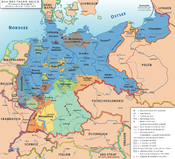
City-states Until 1920 Elder · JuniorUnofficial Categories:- Former principalities
- Former countries in Europe
- States of the Holy Roman Empire
- States and territories established in 1602
- States and territories disestablished in 1918
- 1918 disestablishments
- Ernestine duchies
- Dukes of Saxe-Altenburg
- States of the German Confederation
- States of the North German Confederation
- States of the German Empire
- States of the Weimar Republic
- House of Wettin
- History of Thuringia
- Altenburg
Wikimedia Foundation. 2010.


